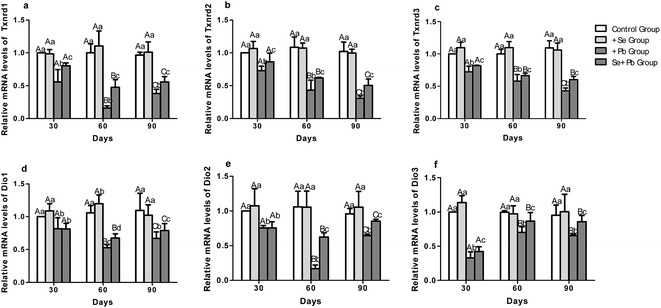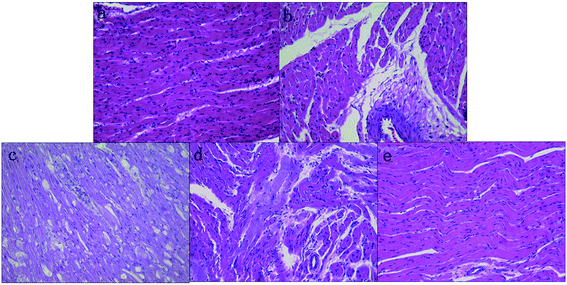 Open Access Article
Open Access ArticleAntagonistic effect of selenium on lead-induced inflammatory injury through inhibiting the nuclear factor-κB signaling pathway and stimulating selenoproteins in chicken hearts
Yanyan Liu†
a,
Xiaoyan Jiao†b,
Xiaojie Teng†c,
Xianhong Gu†*d and
Xiaohua Teng† *b
*b
aCollege of Veterinary Medicine, Northeast Agricultural University, Harbin 150030, People's Republic of China
bCollege of Animal Science and Technology, Northeast Agricultural University, Harbin 150030, People's Republic of China. E-mail: tengxiaohua@neau.edu.cn; Tel: +86-451-55191485
cGrassland Workstation in Heilongjiang Province, Harbin 150067, People's Republic of China
dInstitute of Animal Science, Chinese Academy of Agricultural Sciences, Beijing 100193, People's Republic of China. Tel: +86-010-62815895
First published on 12th May 2017
Abstract
Lead (Pb) is a toxic metal and can damage chicken organs. Selenium (Se) is an essential micronutrient and has antagonistic effect on heavy metal toxicity. However, the toxic effect of Pb on inflammatory factors and selenoproteins, and antagonistic effect of Se on Pb toxicity in chicken hearts remain unclear. In the present study, a chicken model to study Pb and Se was established. Seven-day-old male chickens were randomly divided into the control, the +Se group, the +Pb group, and the Se + Pb group. The feeding program of Pb and Se was as follows: lead acetate was added to drinking water and sodium selenite was added to the standard diet. Relative mRNA levels of four inflammatory factors (nuclear factor-κB (NF-κB), tumor necrosis factor-α, cyclooxygenase-2, and prostaglandin E synthases) and 25 selenoproteins (including glutathione peroxidase 1 (Gpx1), Gpx2, Gpx3, and Gpx4, thioredoxin reductase 1 (Txnrd1), Txnrd2, Txnrd3, iodothyronine deiodinase 1 (Dio1), Dio2, Dio3, selenoprotein n1 (Sepn1), selenoprotein K (Selk), Sels, Sepw1, Selt, Selh, Selm, 15 kDa selenoprotein, Seli, Selu, Selpb, Sepp1, Selo, Sepx1, selenophosphate synthetase 2 (SPS2)) were detected on the 30th, 60th, and 90th days in chicken hearts. The results indicated that Pb poisoning increased mRNA levels of inflammatory factors, decreased mRNA levels of selenoproteins, and caused histological changes in the chicken hearts. Se alleviated Pb-caused all the above changes in the chicken hearts. Our results suggested that Se supplementation alleviated Pb-induced inflammatory injury through inhibiting the NF-κB signaling pathway and stimulating selenoproteins in the chicken hearts.
1. Introduction
Lead (Pb) is a toxic metal and exists in natural environment. Pb-contaminated fodder and water pose potential risks to humans through the food chain. The concentration of Pb increased in cattle and sheep living near a Pb-polluted mining area.1 Pb has a negative influence on the central nervous system,2 and the behavior and mental development of children.3 Pb has adverse effects on animals, such as rat kidneys,4 chicken livers,5 and cartilage tissue6 and Pb induced cardiovascular toxicity in rats.7 A previous study indicated that Pb exposure activated cyclooxygenase-2 (COX-2) in rat vascular smooth muscle cells.8 Inflammation is a characteristic of the clinical syndrome of heart failure.9 Research has investigated the roles of inflammatory markers such as tumor necrosis factor-α (TNF-α) and nuclear factor-κB (NF-κB) in cardiovascular diseases.10 TNF-α could serve as a potential bio-marker for coronary heart disease.11 NF-κB regulates the expression of TNF-α.12 Prostaglandin E2 (PGE2) is a principal mediator of inflammation in diseases.13 Arachidonic acid is transformed into PGE2 via cyclooxygenase enzymes in cells.14 Therefore, NF-κB signaling pathways are important in heart diseases. A study also found that exposure to cadmium (Cd) increased TNF-α in Wistar rat heart tissues.15 However, the mechanism of inflammatory response caused by Pb is still unclear in chicken hearts. Therefore, we investigated the effect of Pb on NF-κB signaling pathway in chicken hearts.Selenium (Se) is an essential micronutrient and can antagonize different heavy metal toxicities16 and hepatocellular carcinoma.17 Se plays an important role in maintaining normal cardiovascular function. Many of its physiologic roles are directly attributed to its presence within selenoproteins in the form of the amino acid selenocysteine.18 Studies have shown that Se deficiency can cause heart damage, such as Keshan disease19 and Chagas' disease.20 However, antagonistic effect of Se on Pb toxicity is still unclear in chicken hearts.
Effect of Pb on mammals and chickens has recently attracted considerable attention. For example, Hao Wang et al.21 studied that Se alleviated Pb-induced increase of relative mRNA expression of inflammation factors and heat shock proteins in chicken livers. However, inflammatory injury induced by Pb and protective effect of Se on Pb poisoning in chicken hearts remain unclear. The aim of the present study was to explore antagonistic effect of dietary Se on inflammatory injury induced by Pb toxicity through measuring mRNA levels of inflammatory factors and selenoproteins, and to provide theoretical basis of remission effect of Se on heart injury induced by Pb in chickens.
2. Materials and methods
2.1 Animal model and tissue sample
One hundred and eighty Hyline male chickens (1 day-old) were acclimated for 7 days and then randomly divided into four groups. The control group was fed basic diet (0.49 mg kg−1 Se) and drinking water. The +Se group was fed sodium selenite (Na2SeO3, analytical reagent grade, Tianjinzhiyuan, Chemical Reagent Co. Ltd., Tianjin, China)-added the basic diet (1 mg kg−1 Se) and drinking water. The +Pb group was fed lead acetate ((CH3OO)2Pb, analytical reagent grade, Tianjinzhiyuan Chemical Reagent Co. Ltd., Tianjin, China)-added drinking water (350 mg L−1 Pb), according to median lethal dose (LD50) for Pb in chickens22 and the need of the chicken experiment in toxicology.23 The Se + Pb group was fed Na2SeO3-added the basic diet (1 mg kg−1 Se) and (CH3OO)2Pb-added drinking water (350 mg L−1 Pb). The chickens were maintained in the Laboratory Animal Center, College of Veterinary Medicine, Northeast Agricultural University, China. Food and water were provided ad libitum.On the 30th, 60th, and 90th days of the experiment, fifteen chickens in each group were randomly selected, and euthanasia was performed. Heart tissues were quickly removed, rinsed with ice-cold, sterile deionized water. Each heart was divided into two parts. One part was fixed with 5% paraformaldehyde for histological observation. Another part was frozen in liquid nitrogen and stored at −80 °C until required. All procedures used in this experiment were approved by the Northeast Agricultural University's Institutional Animal Care and Use Committee under the approved protocol number SRM-06.
2.2 Relative mRNA levels of inflammatory factors and selenoproteins
| Gene | Serial number | Forward primer (5′ → 3′) | Reverse primer (5′ → 3′) |
|---|---|---|---|
| NF-κB | NM_205134 | TCAACGCAGGACCTAAAGACAT | GCAGATAGCCAAGTTCAGGATG |
| TNF-α | NM_204267 | GCCCTTCCTGTAACCAGATG | ACACGACAGCCAAGTCAACG |
| PTGEs | NM_001194983 | GTTCCTGTCATTCGCCTTCTAC | CGCATCCTCTGGGTTAGCA |
| COX-2 | NM_001167718 | TGTCCTTTCACTGCTTTCCAT | TTCCATTGCTGTGTTTGAGGT |
| GPx1 | BX935086.2 | ACGGCGCATCTTCCAAAG | TGTTCCCCCAACCATTTCTC |
| GPx2 | NM_001277854.1 | ACGGCACCAACGAGGAGAT | TTCAGGTAGGCGAAGACGG |
| GPx3 | NM_001163232.1 | CCTGCAGTACCTCGAACTGA | CTTCAGTGCAGGGAG GATCT |
| GPx4 | AF498316 | CTTCGTCTGCATCATCACCAA | TCGACGAGCTGAGTGTAATTCAC |
| Dio1 | Y11110.1 | GCGCTATACCACAGGCAGTA | GGTCTTGCAAATGTCACCAC |
| Dio2 | AF125575.1 | ATTTGCTGATCACGCTTCAG | GCTCAGAAACAGCACCATGT |
| Dio3 | Y11273.1 | CTGTGCATTCGCAAGAAGAT | GCCGACTTGAAGAAGTCCAG |
| Txnrd1 | NM_001030762.2 | TACGCCTCTGGGAAATTCGT | CTTGCAAGGCTTGTCCCAGTA |
| Txnrd2 | NM_001122691.1 | GCTCTTAAAGATGCCCAGCACTAC | GAACAGCTTGAGCCATCACAGA |
| Txnrd3 | NM_001122777.1 | CCTGGCAAAACGCTAGTTGTG | CGCACCATTACTGTGACATCTAGAC |
| Sepn1 | NM_001114972.1 | CAGGATCCATGCTGAGTTCCA | GAGAGGACGATGTAACCCGTAAAC |
| Selk | NM_001025441.2 | GAAGAGGGCCTCCAGGAAAT | CAGCCATTGGTGGTGGACTAG |
| Sels | NM_001024734.2 | GCGTCGCCATCTATCTCATCGT | TCTTCTGCCTTCGCTTCTGTTCTT |
| Selw1 | NM_001166327.1 | TGGTGTGGGTCTGCTTTACG | CCAAAGCTGGAAGGTGCAA |
| Selt | NM_001006557.3 | AGGAGTACAT GCGGG TCATCA | GACAGACAGGAAGGATGCTATGTG |
| Selh | BX932816.2 | CATCGAGCACTGCCGTAG | GACACCTCGAAGCTGTTCCT |
| Selm | CR390234.1 | AAGAAGGACCACCCAGACCT | GCTGTCCTGTCTCCCTC ATC |
| Sep15 | NM_001012926.2 | ACTTGGCTTCTCCAGTAACTTGCT | GCCTACAGAATGGATCCAACTGA |
| Seli | XM_426086.1 | TGCCAGCCTCTGAACTGGAT | TGCAAACCCAGACATCACCAT |
| Selu | NM_001193518.1 | GATGCTTTCAGGCTTCTTCC | CTGTCTTCCTGCTCCAATCA |
| Selpb | XM_003641687.1 | AGGCCAACAGTACCATGGAG | GTGGTGAGGATGGAGATGGT |
| Sepp1 | NM_001031609 | CCAAGTGGTCAGCATTCACATC | ATGACGACCACCCTCACGAT |
| Selo | NM_001115017.1 | CCAGCGTTAACCGGAATGAT | ATGCGCCTCCTGGATTTCT |
| Sepx1 | NM_001135558.1 | TGGCAAGTGTGGCAATGG | GAATTTGAGCGAGCTGCTGAAT |
| SPS2 | NM_001187543.1 | CGTTGGGTATCGGAACTGAC | CGTCCACCAGAGGGTAGAAA |
| GADPH | K01458 | AGAACATCATCCCAGCGT | AGCCTTCACTACCCTCTTG |
2.3 Histological observation
The tissues were placed in 5% paraformaldehyde solution. Paraffin-embedded issue block was performed. Each issue block was sliced into 5 μm-thick sections. The sections were mounted on glass and stained with hematoxylin and eosin. The slides were observed under a light microscope (Eclipse 80i, Nikon, Tokyo, Japan).2.4 Statistical analysis
Statistical analyses of all data were carried out with two-way analysis of variance (ANOVA) using SPSS (version 13; SPSS Inc., Chicago, IL, USA) for Windows. The comparisons for groups were verified by nonparametric as Kruskal–Wallis ANOVA test and Mann–Whitney U test. The data were presented as means ± standard deviation (bars, n = 5). Statistically significant differences: bars with different uppercase letters within the same group at different time points are significantly different (P < 0.05), and bars with different lowercase letters in the different groups at the same time point are significantly different (P < 0.05).3. Results
3.1 NF-κB, TNF-α, COX-2, and PTGEs mRNA expression
Relative mRNA expression of inflammatory factors (NF-κB (Fig. 1a), TNF-α (Fig. 1b), COX-2 (Fig. 1c), and PTGEs (Fig. 1d)) was shown in Fig. 1. All the inflammatory factors in the +Pb group were significantly higher (P < 0.05) than that in the control, +Se, and Se + Pb groups. And all the inflammatory factors in the Se + Pb group were significantly higher (P < 0.05) than those in the control and +Se groups. NF-κB, TNF-α, and COX-2 increased significantly (P < 0.05) with the increase of treatment time in the +Pb group. PTGEs on the 90th day was significantly higher (P < 0.05) than that on the 30th and 60th days in the +Pb and Se + Pb groups. NF-κB on the 60th and 90th days was significantly higher (P < 0.05) than that on the 30th day in the Se + Pb group. TNF-α and COX-2 increased significantly (P < 0.05) with the increase of treatment time.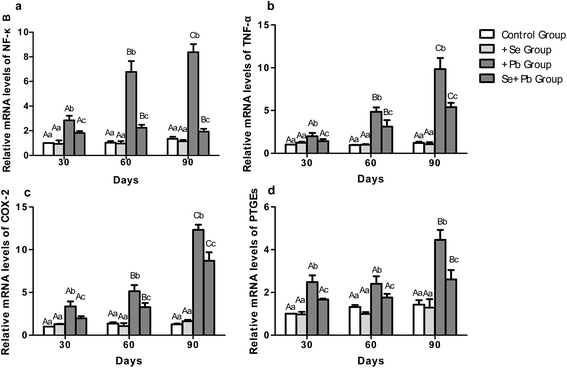 | ||
| Fig. 1 NF-κB, TNF-α, COX-2 and PTGEs mRNA levels in chicken hearts. Fifteen chickens consisted of five replicate pens, with each pen containing three chickens. | ||
3.2 Gpx1, Gpx2, Gpx3, and Gpx4 mRNA expression
Glutathione peroxidase 1 (Gpx1), Gpx2, Gpx3, and Gpx4 mRNA expression was shown in Fig. 2. Relative mRNA levels of all the Gpxs in the +Pb group were significantly decreased (P < 0.05) compared with those in the control, +Se, Se + Pb groups except Gpx1 and Gpx4 on the 30th and 60th days, and Gpx3 on the 30th day. All the Gpxs in the Se + Pb group were significantly decreased (P < 0.05) compared with those in the control and +Se groups except Gpx3 on the 90th day. In the +Pb group, Gpx1 on the 60th and 90th days was significantly decreased (P < 0.05) compared with that on the 30th day. Gpx2 and Gpx3 decreased significantly (P < 0.05) with the increase of treatment time. Gpx4 on the 90th day was significantly increased (P < 0.05) compared with that on the 30th and 60th days.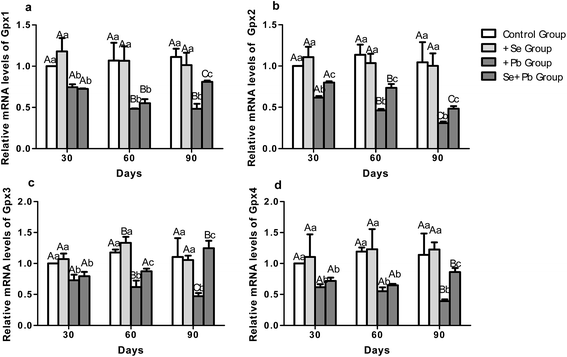 | ||
| Fig. 2 Gpx1, Gpx2, Gpx3, and Gpx4 mRNA levels in chicken hearts. Fifteen chickens consisted of five replicate pens, with each pen containing three chickens. | ||
3.3 Thioredoxin reductases and iodothyronine deiodinases mRNA expression
Relative mRNA expression of thioredoxin reductases (Txnrds) and iodothyronine deiodinases (Dios) was shown in Fig. 3. Txnrd1, Txnrd2, Txnrd3, Dio1, Dio2, and Dio3 in the +Pb group were significantly lower (P < 0.05) than those in the control, +Se, and Se + Pb groups except Dio1 and Dio2 on the 30th day. Txnrds and Dios in the Se + Pb group were significantly lower (P < 0.05) than those in the control and +Se groups.3.4 Relative mRNA expression of 15 selenoproteins
Relative mRNA expression of 15 selenoproteins was detected. As shown in Fig. 4, selenoprotein n1 (Sepn1), selenoprotein K (Selk), Sels, Sepw1, Selt, Selh, Selm, 15 kDa selenoprotein (Sep15), Seli, Selu, Selpb, Sepp1, Selo, Sepx1, selenophosphate synthetase 2 (SPS2) in the +Pb group were significantly decreased (P < 0.05) compared with those in the control, +Se, and Se + Pb groups. All the selenoproteins in the Se + Pb group were significantly decreased (P < 0.05) compared with those in the control and +Se groups.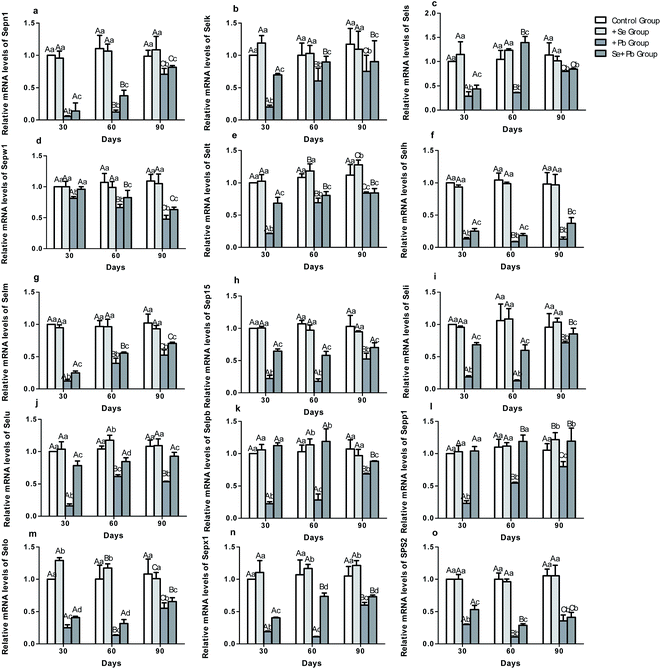 | ||
| Fig. 4 Relative mRNA expression of 15 selenoproteins in chicken hearts. Fifteen chickens consisted of five replicate pens, with each pen containing three chickens. | ||
3.5 Histological observation
Histological results were shown in Fig. 5. In the control group on the 90 day, histology of chicken heart tissue displayed normal structure with regular morphology (Fig. 5a). In the +Pb group on the 30th day (Fig. 5b), there was lightly edema in cardiac muscle cells. In the +Pb group on the 60th day (Fig. 5c), cardiac muscle cells had edema. Muscle fiber pulp had dissolved. Cell hypertrophy and vacuole degeneration were observed. In the +Pb group on the 90th day (Fig. 5d), cardiac muscle cells occurred focal necrosis and inflammatory cell infiltration. In the Se + Pb group (Fig. 5e) on the 90th day, some cardiac muscle fibers were slightly disorganized. Some cardiac muscle cells occurred inflammatory cell infiltration.4. Discussion
Pb can cause inflammatory injury in testicular macrophages of male Swiss albino mice.25 Inflammatory processes play critical roles in the treatment of heart failure.26 NF-κB activation could cause cardiomyopathy and heart failure by evoking an excessive inflammatory response in cardiomyocytes.27 NF-κB regulates proinflammatory cytokines in both innate and adaptive immunity.28 NF-κB was involved in the regulation of COX-2 and TNF-α in Pb-induced immunotoxicity and inflammatory response.29 Excess Pb can induce abnormal microgliosis and astrogliosis in young mice through triggering NF-κB signaling cascades.30 Mingwei Xing et al.31 reported that arsenic induced inflammation response and may cause chicken digestive function regression of gastrointestinal tract by affecting inflammation-related genes. Excess Pb increased COX-2 and PGE2 in human aorta vascular smooth muscle cells.32 Pb can cause inflammatory damage in the peripheral blood lymphocytes of chickens.33 These findings were consistent with our study. Our results indicated that excess Pb increased NF-κB, PTGES, TNF-α, and COX-2 mRNA expression (see Fig. 1) and inflammatory injury (see Fig. 5b–d) in the chicken hearts. Our results indicated that excess Pb induced inflammatory injury through inhibiting NF-κB signaling pathway in the chicken hearts.Previous studies showed that Se has antagonistic effect on toxic heavy metals. Se exerts a protective role against Cd-induced inflammatory cytokines in chicken splenic lymphocytes34 and Pb-induced inflammatory cytokines in chicken peripheral blood lymphocytes.33 Our study was similar to these studies. In our study, we found that NF-κB, TNF-α, COX-2, and PTGEs mRNA levels decreased in the Se + Pb group compared to those in the +Pb group (see Fig. 1). Degree of inflammatory injury in the Se + Pb group was lower than that in the +Pb group (see Fig. 5d and e). Our results indicated that Se antagonized Pb-induced inflammation injury in the chicken hearts.
Selenoproteins are main indicators for some functions of Se in animals. Some selenoproteins are very sensitive to dietary Se in some chicken tissues.35,36 Se deficiency caused the decline of Gpxs activity in chicken immune organs.37 Se deficiency influenced selenoprotein gene expression in chicken muscles.38 Gpx1, Gpx2, Gpx3, Gpx4, Txnrd1, Txnrd2, Txnrd3, Dio1, Dio2, Dio3, Sepn1, Selk, Sels, Sepw1, Selt, Selh, Selm, Sep15, Seli, Selu, Selpb, Sepp1, Selo, Sepx1, SPS2 exist in chickens. These selenoproteins have anti-inflammatory properties and play important roles in inflammatory response,39 immune response,40 and apoptosis.41 One study showed that excess Pb decreased GPx in rat livers and erythrocytes.42 Our results indicated that excess Pb decreased mRNA levels of the 25 selenoproteins (see Fig. 2–4). Dietary Se supplementation alleviated the decrease of Gpx3, Txnrd1, Txnrd2, Txnrd3, Dio2, and Seln mRNA levels induced by aflatoxin B1 in male avian broiler livers.43 Zhao et al.44 found that Se played protective role by increasing mRNA expression of Selk, Seln, Sels, and Selt against Cd in chicken splenic lymphocytes. Gao et al.45 reported that Se alleviated the decline of selenoprotein gene expression induced by Pb in chicken cartilages. In accordance with the above researches, our results indicated that Se alleviated the decline of Gpx2, Gpx3, Gpx4, Txnrd1, Txnrd3, Txnrd3, Dio1, Dio3, Dio3, Sepn1, Selk, Sels, Sepw1, Selt, Selh, Selm, Sep15, Seli, Selu, Selpb, Sepp1, Selo, Sepx1, SPS2 mRNA levels induced by Pb in the chicken hearts.
5. Conclusions
In conclusions, excess Pb increased mRNA levels of NF-κB, TNF-α, COX-2, and PTGEs; and decreased mRNA levels of Gpxs, Txnrds, Dios, Sepn1, Selk, Sels, Sepw1, Selt, Selh, Selm, Sep15, Seli, Selu, Selpb, Sepp1, Selo, Sepx1, and SPS2 in the chicken hearts. Excess Pb changed histology in the chicken hearts. Se alleviated the changes of histology and all the above inflammatory factors and selenoproteins caused by Pb in the chicken hearts. Se supplementation alleviated Pb-induced inflammatory injury through inhibiting NF-κB signaling pathway and stimulating selenoproteins in the chicken hearts.Conflict of interest
The authors declare that there are no conflicts of interest.Acknowledgements
The present work was support by the Agricultural Science and Technology Innovation Program (ASTIP-IAS07), and Key Special Project of National Key Research Program (2016YFD0500507)., the Key Laboratory of Animal Disease Control and Prevention ordinary operated by Northeast Agricultural University (No. 120105) and the Doctoral Research Foundation of Northeast Agricultural University (No. 2012RCB37).References
- J. Rodríguez-Estival, J. A. Barasona and R. Mateo, Environ. Pollut., 2012, 1601, 118–124 CrossRef PubMed.
- J. Kasten-Jolly, H. Yong and D. A. Lawrence, J. Biochem. Mol. Toxicol., 2011, 25, 41–54 CrossRef CAS PubMed.
- S. Hou, L. Yuan, P. Jin, B. Ding, N. Qin, L. Li, X. Liu, Z. Wu, G. Zhao and Y. Deng, Theor. Biol. Med. Modell., 2013, 10, 718 Search PubMed.
- L. Wang, Z. Wang and J. Liu, Hum. Exp. Toxicol., 2010, 29, 581–591 CAS.
- T. Xu, X. Gao and G. Liu, Biol. Trace Elem. Res., 2016, 169, 1–9 CrossRef PubMed.
- S. Zheng, H. Song, H. Gao, C. Liu, Z. Zhang and J. Fu, Biol. Trace Elem. Res., 2016, 173, 177–184 CrossRef CAS PubMed.
- M. A. Ansari, Z. H. Maayah, S. A. Bakheet, A. O. El-Kadi and H. M. Korashy, Toxicology, 2013, 306, 40–49 CrossRef CAS PubMed.
- M. R. Simões, A. Aguado, J. Fiorim, E. A. Silveira, B. F. Azevedo, C. M. Toscano, O. Zhenyukh, A. M. Briones, M. J. Alonso and D. V. Vassallo, Toxicol. Appl. Pharmacol., 2015, 283, 127–138 CrossRef PubMed.
- J. Hartupee and D. L. Mann, J. Cardiovasc. Transl. Res., 2013, 6, 485–492 CrossRef PubMed.
- T. Hamid, Y. Gu, R. V. Ortines, C. Bhattacharya, G. Wang, Y. T. Xuan and S. D. Prabhu, Circulation, 2009, 119, 1386–1397 CrossRef CAS PubMed.
- P. R. Garg, K. N. Saraswathy, A. K. Kalla, E. Sinha and P. K. Ghosh, Gene, 2012, 514, 69–74 CrossRef PubMed.
- S. Vallabhapurapu and M. Karin, Annu. Rev. Immunol., 2009, 27, 693–733 CrossRef CAS PubMed.
- V. Sreeramkumar, M. Hons, C. Punzon, J. V. Stein, D. Sancho, M. Fresno and N. Cuesta, Immunol. Cell Biol., 2016, 94, 39–51 CrossRef CAS PubMed.
- J. Y. Park, M. H. Pillinger and S. B. Abramson, Clin. Immunol., 2006, 119, 229–240 CrossRef CAS PubMed.
- N. Yazıhan, M. K. Koçak, E. Akçıl, O. Erdem, A. Sayal, C. Güven and N. Akyürek, Anadolu Kardiyol. Derg., 2011, 11, 479–484 Search PubMed.
- H. Y. Cogun, Ö. Fıra, Ö. Fırat, T. A. Yüzereroǧlu, G. Gök, F. Kargin and Y. Kötemen, J. Biochem. Mol. Toxicol., 2012, 26, 117–122 CrossRef CAS PubMed.
- Z. Zhang, M. Bi, Qi. Liu, J. Yang and S. Xu, Oncotarget, 2016, 7, 77110–77116 Search PubMed.
- L. V. Papp, A. Holmgren and K. K. Khanna, Antioxid. Redox Signaling, 2010, 12, 793–795 CrossRef CAS PubMed.
- L. V. Papp, J. Lu, A. Holmgren and K. K. Khanna, Antioxid. Redox Signaling, 2007, 9, 5–806 Search PubMed.
- M. T. Rivera, A. P. de Souza, A. H. Moreno, S. S. Xavier, J. A. Gomes, M. O. Rocha, R. Correaoliveira, J. Nève, J. Vanderpas and T. C. Araújojorge, Am. J. Trop. Med. Hyg., 2002, 66, 706–712 CrossRef PubMed.
- H. Wang, S. Li and X. Teng, Biol. Trace Elem. Res., 2015, 171, 437–444 CrossRef PubMed.
- V. E. Vengris and C. J. Maré, Can. J. Comp. Med., 1974, 38, 328–335 CAS.
- C. D. Klaassen and J. B. Watkins, Casarett & Doull's Toxicology: the Basic Science of Poisons, Mc Graw-Hill, 2013, vol. 63, p. 104 Search PubMed.
- M. W. Pfaffl, Nucleic Acids Res., 2001, 29, 2002–2007 CrossRef.
- S. A. S. K. Barbhuiya, S. Chakraborty and M. Sengupta, Mod. Res. Inflammation, 2013, 2, 75–81 CrossRef.
- A. Briasoulis, E. Androulakis, T. Christophides and D. Tousoulis, Heart Failure Rev., 2016, 21, 1–8 CrossRef PubMed.
- H. J. Maier, T. G. Schips, A. Wietelmann, M. Krüger, C. Brunner, M. Sauter, K. Klingel, T. Böttger, T. Braun and T. Wirth, Proc. Natl. Acad. Sci. U. S. A., 2012, 109, 11794–11799 CrossRef CAS PubMed.
- Q. T. Li and I. M. Verma, Nat. Rev. Immunol., 2002, 2, 725–734 CrossRef CAS PubMed.
- C. M. Liu, Y. Z. Sun, J. M. Sun, J. Q. Ma and C. Cheng, Biochim. Biophys. Acta, Gen. Subj., 2012, 1820, 1693–1703 CrossRef CAS PubMed.
- J. T. Liu, B. Y. Chen, J. Q. Zhang, F. Kuang and L. W. Chen, Toxicol. Lett., 2015, 239, 97–107 CrossRef CAS PubMed.
- M. Xing, P. Zhao, G. Guo, Y. Guo, K. Zhang, L. Tian, Y. He, H. Chai and W. Zhang, Biol. Trace Elem. Res., 2015, 167, 1–12 CrossRef PubMed.
- W. C. Chang, C. C. Chang, Y. S. Wang, Y. S. Wang, W. T. Weng, T. Yoshioka and S. H. Juo, Toxicology, 2011, 279, 45–53 CrossRef CAS PubMed.
- G. X. Sun, Y. Chen, C. P. Liu, S. Li and J. Fu, Biol. Trace Elem. Res., 2016, 172, 474–480 CrossRef CAS PubMed.
- S. Liu, F. Xu, J. Fu and S. Li, Biol. Trace Elem. Res., 2015, 168, 1–9 CrossRef PubMed.
- H. D. Yao, Q. Wu, Z. W. Zhang, J. L. Zhang, S. Li, J. Q. Huang, F. Z. Ren, S. W. Xu, X. L. Wang and X. G. Lei, J. Nutr., 2013, 143, 613–619 CrossRef CAS PubMed.
- H. D. Yao, W. Liu, W. C. Zhao, R. F. Fan, X. Zhao, P. A. Khoso, Z. W. Zhang and S. W. Xu, RSC Adv., 2014, 4, 64032–64042 RSC.
- Z. W. Zhang, Q. H. Wang, J. L. Zhang, S. Li, X. L. Wang and S. W. Xu, Biol. Trace Elem. Res., 2012, 149, 352–361 CrossRef CAS PubMed.
- H. Yao, W. Zhao, X. Zhao, R. Fan, P. A. Khoso, Z. Zhang, W. Liu and S. Xu, Biol. Trace Elem. Res., 2014, 161, 318–327 CrossRef CAS PubMed.
- S. A. Mattmiller, B. A. Carlson, J. C. Gandy and L. M. Sordillo, J. Nutr. Sci., 2014, 25, 647–654 CAS.
- Z. H. Jiang, P. A. Khoso, H. D. Yao, Z. W. Zhang, X. Y. Zhang and S. Xu, RSC Adv., 2015, 5, 37896–37905 RSC.
- Y. H. Han, Z. W. Zhang, J. Su, B. Zhang, S. Li and S. W. Xu, Biol. Trace Elem. Res., 2012, 147, 395–402 CrossRef CAS PubMed.
- T. O. Omobowale, A. A. Oyagbemi, A. S. Akinrinde, A. B. Saba, O. T. Daramola, B. S. Ogunpolu and J. O. Olopade, Environ. Toxicol. Pharmacol., 2014, 37, 1202–1211 CrossRef CAS PubMed.
- L. H. Sun, N. Y. Zhang, M. K. Zhu, L. Zhao, J. C. Zhou and D. S. Qi, J. Nutr., 2016, 146, 655–661 CrossRef CAS PubMed.
- W. Zhao, W. Liu, X. Chen, Y. Zhu, Z. Zhang, H. Yao and S. Xu, Biol. Trace Elem. Res., 2014, 161, 328–333 CrossRef CAS PubMed.
- H. Gao, C. P. Liu, S. Q. Song and J. Fu, Biol. Trace Elem. Res., 2016, 172, 234–241 CrossRef CAS PubMed.
Footnote |
| † All authors have read the manuscript and agreed to submit it in its current form for consideration for publication in RSC Advances. |
| This journal is © The Royal Society of Chemistry 2017 |

